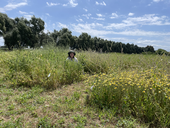- Author: Justin Valliere
- Posted by: Sam Romano

One of the first steps in ecological restoration is often controlling invasive weeds, which can be a major barrier to native plant establishment. But what happens after restoration is complete? At most sites, weed pressure is an ongoing challenge that land managers must grapple with to maintain the diversity, structure, and functioning of native plant communities.
The Invasive Weed & Restoration Ecology Lab at UC Davis is currently exploring the use of “competitive planting” as a method for weed suppression in restored grassland communities. As part of a USDA-funded project, we are evaluating what seed mixes can best facilitate the establishment of native perennial bunchgrasses while also preventing reinvasion of...
- Author: Trina Kleist
- Posted by: Gale Perez

It all started with pumpkin seeds
Justin Valliere has been hired to expand the Department of Plant Sciences' reach in the fields of invasion and restoration ecology. Valliere started as an assistant professor of UC Cooperative Extension in July.
Valliere seeks ways to restore California's native plant communities amid the onslaught of invasive plants and a range of environmental changes. He thinks it's important to bring youngsters into the research world, training them to care about nature and inspiring them to form the next generation of restoration professionals. Cooperative Extension offers a great way to...
- Author: Elise S Gornish
In California, a general requirement of plant species used for revegetation and restoration projects is its classification as a native species. However, the high cost of native plant materials is one of the dominant obstacles to effective revegetation nationwide. The exclusive use of native plants may also inhibit revegetation success because natives may not compete well with existing invasive species, and may not establish as readily as non-natives. As a result, in some cases, non-native plants could provide greater management value than natives for revegetation and restoration projects. For example, rapid establishment rates of non-natives in high-stress environments can also provide utility for erosion control or revegetating...
- Author: Elise S Gornish
Please save the date for the 2nd annual Do No Harm workshop focusing on 'Considerations for the use of non-local species in ecological restoration'. The event will be held in Davis, CA on November 15th 2016. For information and to register, go here: http://ucanr.edu/sites/UC_ANR_Do_No_Harm/
Topics covered: Geographical sourcing of reliable ecotypes and species; management of conservation lands and policies constraining management; biogeography and current/future climate considerations for plant material selection, including non-natives; the role of breeding system, genetic structure, and phenotypic plasticity in...
- Posted by: Gale Perez

Just got the following announcement today.
*********************
SAVE THE DATE! – November 5, 2015
For the inaugural Do No Harm workshop: Considerations of pathogens, pests, and plant disease in restoration...


